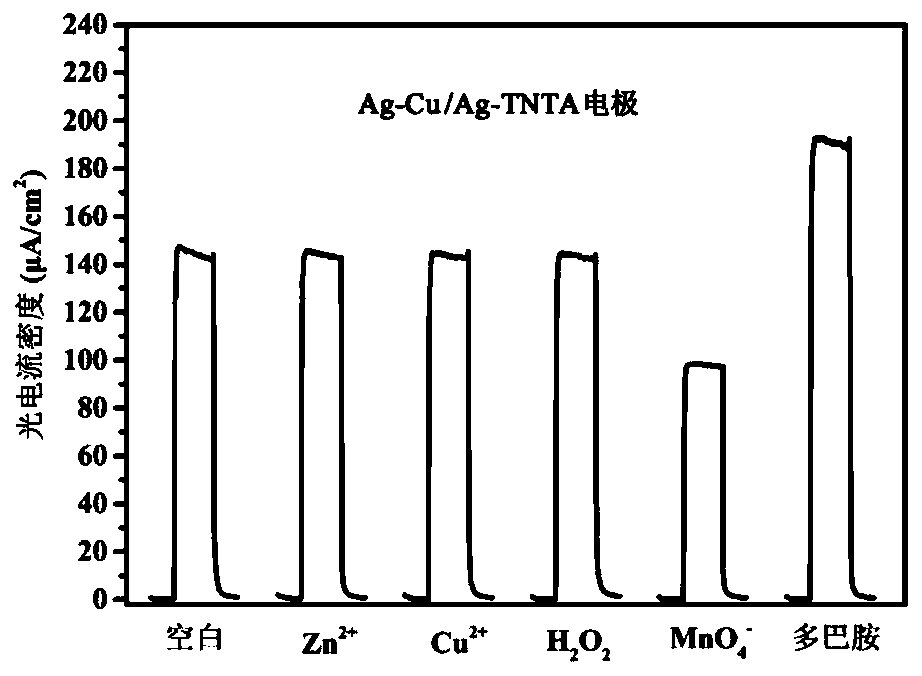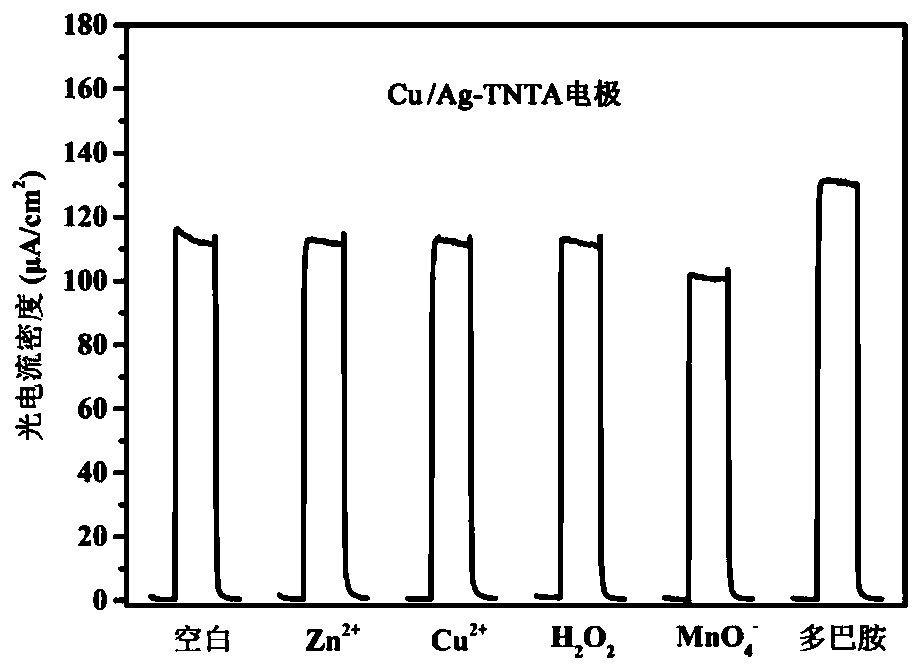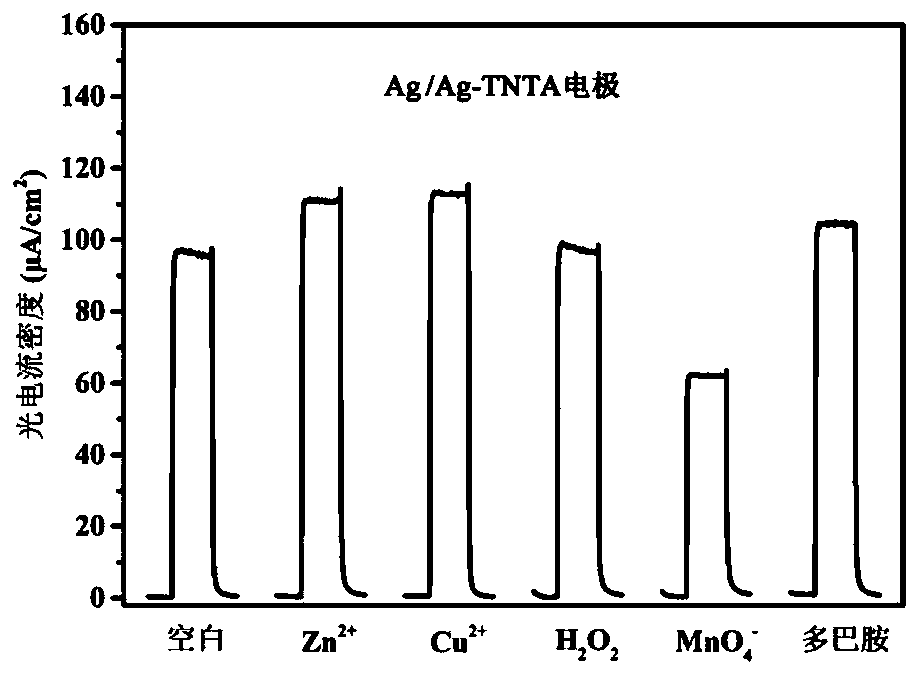Preparation method of titanium oxide nanotube array-based photoelectrochemical detection electrode
A titanium oxide nanotube and photoelectrochemical technology, applied in the field of analysis and detection, can solve the problems of difficult promotion, easy agglomeration of active substances, poor conductivity, etc., and achieve the effects of improving the uniformity of deposition and dispersion, the fineness of metal particles, and the reduction of interfacial tension.
- Summary
- Abstract
- Description
- Claims
- Application Information
AI Technical Summary
Problems solved by technology
Method used
Image
Examples
Embodiment 1
[0034] (1) Clean the Ti sheet (10mm×20mm×0.3mm) ultrasonically with ethanol and distilled water to remove the oil on the surface of the Ti sheet. Prepare a mixed solution with 0.15g of ammonium fluoride, 5g of distilled water and 45g of ethylene glycol, insert the 10mm of the lower end of the Ti piece into the mixed solution, use the Ti piece as the anode, and use the Pt piece as the cathode. Anodize under the conditions for 3 hours to form a titanium dioxide nanotube array film (marked as TNTA) on the surface of the metal titanium sheet; after the reaction, the sample sheet is washed with distilled water and dried.
[0035] (2) Prepare a 0.03M silver nitrate solution containing 0.05M nitric acid and 0.05M ethanolamine. Soak TNTA in 10ml silver nitrate solution for 10min, then wash off the excess solution on the surface of the sample piece with distilled water, put it into 10ml 0.1M NaOH solution and soak it for 10min, and finally soak the sample piece in distilled water for 5...
Embodiment 2
[0045] (1) Prepare an electrolyte solution with 0.1 g of ammonium fluoride, 7.5 g of distilled water and 42.5 g of ethylene glycol. The process steps are the same as in Example 1 (1), and anodic oxidation is carried out at 35° C. and 45 V for 2 hours to prepare TNTA.
[0046] (2) Prepare a 0.05M silver nitrate solution containing 0.1M nitric acid and 0.1M ethanolamine, the process steps are the same as in Example 1(2), and co-deposit twice to prepare Ag-TNTA.
[0047] (3) A copper-silver ion mixed solution containing 0.01M nitric acid, 0.01M ethanolamine, 0.005M silver nitrate and 0.045M copper nitrate was prepared, and the deposition process was the same as in Example 1 (3), and a total of 10 depositions were performed.
[0048] Add 0.5g of hydrazine hydrate into 100ml of 0.5M NaOH solution, stir to dissolve, and prepare a reducing solution. The Ag-Cu / Ag-TNTA electrode can be prepared by carrying out the hydrothermal reduction reaction according to the process conditions of E...
Embodiment 3
[0050] (1) Prepare an electrolyte solution with 0.2 g of ammonium fluoride, 2.5 g of distilled water and 47.5 g of ethylene glycol. The process steps are the same as in Example 1 (1), and anodized at 45° C. and 35 V for 4 hours to prepare TNTA.
[0051] (2) A 0.01M silver nitrate solution containing 0.01M nitric acid and 0.01M ethanolamine was prepared, the process steps were the same as in Example 1(2), and Ag-TNTA was prepared by co-depositing 9 times.
[0052] (3) Prepare a copper-silver ion mixed solution containing 0.1M nitric acid, 0.1M ethanolamine, 0.09M silver nitrate and 0.01M copper nitrate. The deposition process is the same as in Example 1 (3), and the total deposition is 2 times.
[0053] Add 0.1g of formaldehyde into 100ml of 0.1M NaOH solution, stir to dissolve, and prepare a reducing solution. The Ag-Cu / Ag-TNTA electrode can be prepared by carrying out the hydrothermal reduction reaction according to the process conditions of Example 1 (3).
PUM
 Login to View More
Login to View More Abstract
Description
Claims
Application Information
 Login to View More
Login to View More - R&D
- Intellectual Property
- Life Sciences
- Materials
- Tech Scout
- Unparalleled Data Quality
- Higher Quality Content
- 60% Fewer Hallucinations
Browse by: Latest US Patents, China's latest patents, Technical Efficacy Thesaurus, Application Domain, Technology Topic, Popular Technical Reports.
© 2025 PatSnap. All rights reserved.Legal|Privacy policy|Modern Slavery Act Transparency Statement|Sitemap|About US| Contact US: help@patsnap.com



